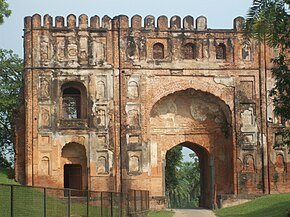Gauḍa (city)
| গৌড় | |

The historical entry gate to Gaur
|
|
| Alternate name | Lakhnauti |
|---|---|
| Location | West Bengal, India |
| Coordinates | 24°52′0″N 88°8′0″E / 24.86667°N 88.13333°ECoordinates: 24°52′0″N 88°8′0″E / 24.86667°N 88.13333°E |
| Type | Settlement |
| Length | 7 1/8 km |
| Width | 1 – 2 km |
| Area | 20 to 30 km2 |
| History | |
| Founded | 15th century (earlier establishment not clear) |
| Abandoned | 16th century |
Gauḍa, Gaur, or Gour (Bengali: গৌড়), also known as Lakhnauti, is a ruined city on the India-Bangladesh border, most of the former citadel is located in present-day the Malda district of West Bengal, India, while a smaller part is located in Nawabganj District of Bangladesh. This city was on the east bank of the Ganges river, 40 kilometres (25 mi) downstream from Rajmahal, 12 km south of Malda. Howeverver, the current course of the Ganges is far away from the ruins.
Lakshmanavati or Lakhnauti gathered prominence during the Sena dynasty, with the name of the city, often attributed to the Sena king Lakshman Sena. Prior to the accession of the Sena dynasty, Gauda region was under the control of the Pala dynasty and, in all probability, Karnasuvarna, the capital of Shashanka, served as the administrative headquarter. For example, the Khalimpur copperplate inscription of Dharmapal, refers to the monarch as Gaudeshwar (lord of Gauda). It is possible that, the Sena dynasty, that supplanted the Pala dynasty in Bengal proper (and to Gauda region) felt the need for a new administrative capital, to reduce the Pala influence. It is possible that the process might have been started by Vijay or Ballal Sena – but given the final shape by Lakshmana Sena. In fact Lakshmanasena had the administrative capital at Lakhnauti while a lesser capital (more likely a retreat in his later days) at Nadia. It was in the later capital, possibly less defended, that he was surprised by Ikhtiyar-ud-din Mohammad ibn Bakhtiyar Khalji.
The area was known as Gauḍa (ablate of Sankrit guḍa, meaning sweet or molasses or root) at the time was under the rule of famous Bengali kings such as Shashanka. In the 7th century Gopala by a democratic election in Gauḍa became the first independent Buddhist king of Bengal and founded the Pala Empire. The Pala dynasty ruled for nearly four centuries between the mid to late 8th century to 12th century CE. The Palas were often described by opponents as the Lords of Gauḍa. It was also a prosperous city during the Sena dynasty's rule in Bengal. However, its most well documented history begins with its conquest in 1198 by the Muslims, who retained it as the chief seat of their power in Bengal for more than three centuries. Around the year 1350, the Sultans of Bengal established their independence, and transferred their seat of government to Pandua (q.v.), also in Malda district. To build their new capital, they plundered Gauḍa of every monument that could be removed. When Pandua was in its turn deserted (1453), Gauḍa once more became the capital under the name Jannatabad; it remained so as long as the Muslim kings retained their independence. In 1565 Sulaiman Khan Karrani, a Pashtun ruler, abandoned it for Tanda, a place somewhat nearer the Ganges. Gauḍa was sacked by Sher Shah in 1539, and was occupied by Akbar's general Munim Khan in 1575, when Daud Khan Karrani, the last of the Afghan dynasty, refused to pay homage to the Mughal emperor. This occupation was followed by an outbreak of the plague and course change of the Ganges, which completed the downfall of the city. Since then it has been little better than a heap of ruins, almost overgrown with jungle.
...
Wikipedia

